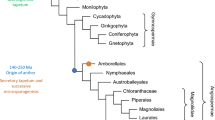Abstract.
Critical morphological synapomorphies have not been found in support of the Acoranan hypothesis, the molecular phylogenetic discovery that Acoranae are the basal monocots. The previously undetermined pattern of anther wall development in Acorus has been suggested to be one such character. Two main types of anther wall development have been recognized: 1) the “monocotyledonous” type, which characterizes both monocots and dicots, and 2) the “dicotyledonous” type, which is almost exclusively found among dicots. An anatomical study of anther wall development in Acorus was here undertaken using the electron microscope. Development of the anther wall in Acorus was found to be somewhat irregular or perhaps even intermediate between the two types although largely consistent with the “monocotyledonous” type. The presumed significance of anther wall development and other critical morphological characters to the Acoranan hypothesis in the absence of knowledge about the sister group to the monocots is evaluated.
Similar content being viewed by others
Author information
Authors and Affiliations
Additional information
Received August 28, 2000 Accepted February 19, 2001
Rights and permissions
About this article
Cite this article
Duvall, M. An anatomical study of anther development in Acorus L.: Phylogenetic implications. Plant Syst. Evol. 228, 143–152 (2001). https://doi.org/10.1007/s006060170025
Issue Date:
DOI: https://doi.org/10.1007/s006060170025




